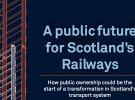A report calling for Scotland’s railways to be publicly owned is backing the co-operative model as one of the ownership options.
One of the findings is that there is a 40% efficiency gap between the UK rail system and comparative countries in Europe where the rail network is operated on different principles.
 The TSSA transport union and the Common Weal think-tank report, A public future for Scotland’s Railways, reveals that in 2015-16, Abellio Scotrail received £293m in direct government funding, amounting to nearly 45.6% of its total income. This proportion is higher than anywhere else in the UK.
The TSSA transport union and the Common Weal think-tank report, A public future for Scotland’s Railways, reveals that in 2015-16, Abellio Scotrail received £293m in direct government funding, amounting to nearly 45.6% of its total income. This proportion is higher than anywhere else in the UK.
The research suggests three possible alternatives for running ScotRail: a public body similar to Deutsche Bahn in Germany or SNCF in France; an integrated public transport body responsible for various modes of public transport; or a co-operative model with the new rail company owned by employees and passengers.
The report says the co-op option represents a “potential governance structure which could be applied in a successful manner to a future Scottish rail company”.
It adds: “This would be a less orthodox model of rail governance than either a conventional arms-length public body or an integrated public transport operator, as well as one without any direct international precedents.”
A rail co-operative would be an innovative approach to running the railways, according to the author. But they highlight that, in practice, any co-operative Scottish rail company would not be wholly owned by either workers or passengers.
They add: “Given its status as the main funder of the railways, as well as the importance of the railways to the public at large, the Scottish government would play a key role in the governance and ownership of such a body, and the democratic institutions in Holyrood should always be responsible for setting the ultimate strategic aims of Scotrail.
“In addition, the present subsidy-based model of financing should be retained, and a rail co-operative should be required to reinvest any operating profits into improving its service.”
A rail co-op would also include workers (potentially through unions) and passengers, such as season ticket holders, as well as the Scottish government.
The authors said: “Giving workers and passengers a direct stake in the success or failure of Scotrail may in turn facilitate more effective decision-making than would be possible with a single Scottish government shareholder, by creating a mutual incentive for the sometimes conflicting objectives of passengers, workers and central government to be resolved without the quality of service being adversely affected.”
No matter what operating model was chosen, the authors believe that co-operative values – including democracy, equality and solidarity – should play an important role in informing the social ethos of a future publicly-owned operator of Scotrail.
The idea for co-operative models of rail ownership was first put forward in 2011 in a report by the Co-operative Party called the People’s Rail. The same year another report by Christian Wolmar commissioned by Co-operatives UK also argued for co-operative rail as a radical solution.
Labour/Co-op MSP Neil Bibby, responding on behalf of the Co-operative Party, said: “Whichever model is chosen, the report acknowledges that co-operative values must shape the new philosophy of the new ScotRail.
“That’s why workers and passengers should have a significant and meaningful voice in the governance of our railways. A socially responsible, sustainable operator, making Scotland greener and fairer. A publicly owned railway run for people, not profit.”